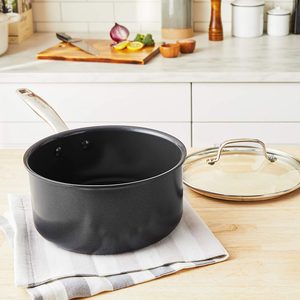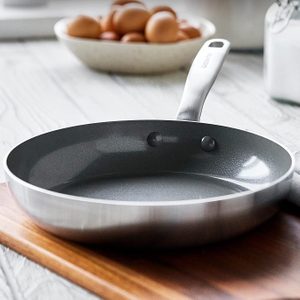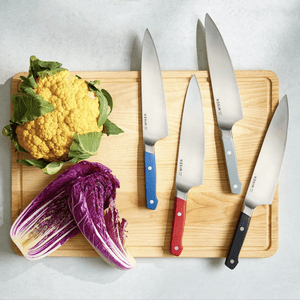How to Make Miso Ramen That’s Packed with Flavor
Updated: Mar. 19, 2023

Rich but still light, miso ramen delivers comfort in a bowl. Topped with fresh chewy noodles, seasonal vegetables and an egg, you'll be shocked you made this in under an hour.
Ramen is a classic Japanese soup that combines a flavorful broth, chewy noodles, protein and vegetables. While there are many ways to make ramen, the three basic varieties of ramen broth are miso (from fermented soy beans), shio (from salt) and shoyu (from soy sauce).
Miso ramen, the type we’re making today, is characterized by its silky rich umami-packed broth made with miso paste. While the classic pork-based broth typically takes a long time to brew to extract and concentrate flavor, we’ll show you how to speed up the process at home. The recipe is wonderfully customizable to anyone’s tastes.
What Is Miso Ramen?
Miso, made from fermented soybeans, is the base of miso ramen broth. It’s all about creating an umami-packed broth with tons of flavor. You can find miso paste in white, red or mixed (awase miso) flavors; the darker the color, the bolder the flavor. Any flavor works for this dish and will yield a slightly different flavor profile.
How Do You Make Miso Ramen?
To make the broth, you’ll need to first make a dashi, a type of Japanese stock. You can do this by combining kombu (dried seaweed) and dried shiitake mushrooms for a vegan dashi. Then saute aromatics like garlic, ginger and onions to bring out a natural sweetness. Combine it all with water, flavorings like soy sauce and sesame oil and, finally, miso paste. Hungry for more? Learn how to make vegan ramen.
After making the miso broth, have some fun in preparing toppings to complement the delicious flavor. Cook noodles so they’re al dente and perhaps top the bowl with a boiled egg, bok choy and corn.
Miso Ramen Recipe
Here’s what you’ll need to make a hearty bowl of veggie miso ramen. This recipe serves two, so if you’d like to feed more, double or triple the ingredients.
Ingredients

- 1 dried kombu sheet
- 8-10 dried shiitake mushrooms
- Neutral oil
- 1-1/2 tablespoons grated ginger
- 1/2 bunch green onions, chopped
- 2 cloves garlic, minced
- 2 tablespoons sesame seeds
- 2 tablespoons red miso paste
- 1 tablespoon soy sauce
- 1 cup unsweetened plant-based milk
- 1 teaspoon sesame oil
- 1 package ramen noodles
- Optional: 1 teaspoon Sriracha or gochujang
Toppings:
- 2 eggs
- 2 baby bok choy, sliced
- 2 asparagus spears, sliced
- 1 chard leaf
- 1/2 cup sliced mushrooms
- 1 large carrot, chopped into matchsticks
- 1/2 cup chopped cabbage
- 2 green onions, sliced
- 1/2 cup frozen corn
- 1 Japanese eggplant, sliced
- 1/4 block of firm tofu
- Optional: sesame seeds, dried seaweed (nori), togarashi, kimchi, hot chili oil
Tools
Directions

Step 1: Make dashi
Fill a medium saucepan with 5 cups of water, kombu and shiitakes. Place on the stove on high heat. Right before it comes to a boil, turn off the heat. Remove kombu and mushrooms and use dashi broth as follows below.
Editor’s Tip: If you’re not making soup right away, remove the kombu and shiitakes and let the broth cool to room temperature. Store in an airtight container in the fridge for a week or freezer for a month.
Step 2: Prep aromatics and sesame seeds
Meanwhile, in a skillet over medium heat, add a drizzle of neutral oil and saute ginger, green onions and garlic until aromatic.
Using a mortar and pestle or spice grinder, grind toasted sesame seeds into a fine powder. Set aside.
Step 3: Finish ramen broth
Add miso paste along with Sriracha or gochujang (if using) to the dashi. Thoroughly stir in the miso; then add sauteed aromatics, ground sesame seeds, soy sauce, plant-based milk and sesame oil. Reduce the heat and let simmer for 5 to 10 minutes. Taste and season accordingly.
Editor’s Tip: Break up any clumps with the back of a spoon. You can also press it through a mesh sieve to make sure the miso paste is silky smooth.
Step 4: Prepare toppings
To make soft-boiled eggs: Fill a small pot halfway with water and add eggs. Place the lid on and turn it to medium-high heat. Once the water boils, turn the heat off and set a timer for 6 minutes. Prep a colander or ice bath while you wait, then immediately transfer the eggs to cool. Carefully crack the shells to peel and slice in half.
To prepare vegetable toppings: Slice or dice vegetables into bite-size pieces and saute in a pan with a drizzle of cooking oil. Season with a pinch of salt and cook till the veggies brown a bit and set aside. If using bean sprouts or spinach, you can blanch them in a pot of boiling water for 2 minutes and strain them, squeezing out any moisture.
To prepare tofu: Cube tofu and lightly coat with a bit of corn starch. In a wide pan, fry tofu in oil until golden brown on all sides. Transfer to a plate, season with salt and set aside.
To prepare raw toppings: Chop into small pieces.
Step 5: Cook noodles
Cook the ramen noodles according to package directions.
Editor’s Tip: Be sure to the strain noodles and rinse with cold water to prevent them from overcooking.
Step 6: Assemble bowls of miso ramen

Place ramen and the prepared toppings in your bowls, then pour the broth over the top. Enjoy!
Miso Ramen Tips
Taste the broth as you go
It’s important to taste and adjust the flavor as you cook. If the broth needs more salt, add more soy sauce. If it needs more umami, add another teaspoon or two of miso paste. The flavor of different brands and varieties of miso can vary. Use your taste buds to help you find the perfect flavor!
Prepare toppings in one pot
Since there are many steps to building a bowl of ramen, preparing the ingredients can seem overwhelming. But once you have a large pot of water boiling, you can use that water for toppings, like bok choy and broccoli, as well as your noodles.
Once the pot is boiling, drop each vegetable into the water to let it blanch for a few minutes till the desired doneness is reached. Then, using a slotted spoon or mesh strainer, remove the vegetables to drain on the side. Then, boil your noodles and strain all the water. The water will turn a bit murky if you cook the noodles first, so do vegetables, then noodles.
Make miso ramen your own
There are so many ways to riff on this version of miso ramen. Try these ramen upgrades to give it the spin you crave.
























